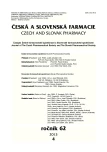-
Medical journals
- Career
Content uniformity of warfarin-containing mixtures and tablets
Authors: Aleš Franc; Jan Muselík; Radka Máslová; Jana Hadrabová
Authors‘ workplace: Veterinární a farmaceutická univerzita Brno, Farmaceutická fakulta, Ústav technologie léků, Brno
Published in: Čes. slov. Farm., 2013; 62, 177-181
Category: Original Articles
Overview
This experimental study describes the method of direct compression of powder mixtures composed of warfarinum sodium salt. Warfarinum is a drug with a narrow therapeutics index. The aim of this study is to find a suitable composition and a process of preparing tablets with the best uniformity. The content uniformity is very important for the safety of the therapy. This study links up with the already published article including the results of content uniformity of mixtures and tablets prepared by direct compression. These mixtures contain fillers with different density and distribution size of the particles (excipients with digger particles were used in this experiment). The study is focused on the influence of magnesium stearate, which was added at the beginning of the homogenization or after the mixing of the other components. In addition to content uniformity and physical characteristics of the tablets, the study also evaluated the uniformity and physical characteristics of the mixtures. In this experimental study it has been found out that content uniformity is influenced by the total time of homogenization and the addition of magnesium stearate and much less by the distribution size of the particles of excipients in the mixtures. The appropriate selection of process parameters is important for obtaining tablets respecting the strict criterion of Bergum distribution. This distribution is a part of the GMP by the evaluation of the content uniformity in the U.S.
Keywords:
warfarin • content uniformity • homogenization • GMP
Sources
1. Hirsh J., Dalen J. E., Anderson D. R., Poller R., Bussey H., Ansell J., Deykinn D. Oral anticoagulants: mechanism of action, clinical effectiveness, and optimal therapeutic range. CHEST 2011; 119, S8–21, http://journal.publications.chestnet.org.
2. Muselík J., Franc A. Hodnocení obsahové stejnoměrnosti tablet s nízkým obsahem léčivé látky s úzkým terapeutickým indexem. Čes. slov. Farm. 2012; 61, 271–275.
3. Blend uniformity analysis. Guidance for industy. CDER. August 1999, http://www.fda.gov.
4. Mohan P., Sharma N., Gupta M. K., Khinchi M. P., Agrawal D., Kabra M. P. A review on validation of solid dosages form. JSRP 2012; 1, 18–22.
5. Swarbrick J. Encyclopedia of pharmaceutical technology. Informa healthcare, 3th ed. New York, 2007, 1171 s.
6. Boehm G., Clark J., Dietrick J., Foust L., Garcia T., Gavini M., Geoffroy J. M., Jimenez P., Mergen G., Muzzio F., Planchard J., Prescott J., Timmermans J., Takiar N., Whiteman D. Results of statistical analysis of blend and dosage unit content uniformity data obtained from the Product Quality Research Institute Blend Uniformity Working Group data-mining effort. PDA J. Pharm. Sci. Tech. 2004; 58, 62–74.
7. Berman J., Elinski D. E., Gonzales C. R., Jimenez P. J., Planchard J. A., Tlachac R. J., Vogel P. F. Blend uniformity analysis: validation and in-process testing. PDA J. Pharm. Sci. Tech. 1997; 51, S1–99.
Labels
Pharmacy Clinical pharmacology
Article was published inCzech and Slovak Pharmacy

2013 Issue 4-
All articles in this issue
- Development of financial participation of patients in the costs of pharmacotherapy in the years 2008–2012
- Effect of abiotic elicitation on the sanguinarine production and polyphenol oxidase activity in the suspension culture of Eschscholtzia californica CHAM.
- Antioxidant activity of extracts and HPLC analysis of flavonoids from Capella bursa-pastoris (L.) Medik
- Content uniformity of warfarin-containing mixtures and tablets
- Drugs of a Baroque monastery pharmacy
- Rare diseases in Italy: analysis of the costs and pharmacotherapy
- Czech and Slovak Pharmacy
- Journal archive
- Current issue
- Online only
- About the journal
Most read in this issue- Drugs of a Baroque monastery pharmacy
- Content uniformity of warfarin-containing mixtures and tablets
- Antioxidant activity of extracts and HPLC analysis of flavonoids from Capella bursa-pastoris (L.) Medik
- Effect of abiotic elicitation on the sanguinarine production and polyphenol oxidase activity in the suspension culture of Eschscholtzia californica CHAM.
Login#ADS_BOTTOM_SCRIPTS#Forgotten passwordEnter the email address that you registered with. We will send you instructions on how to set a new password.
- Career

